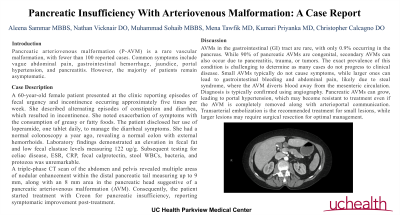Sunday Poster Session
Category: Biliary/Pancreas
P0193 - Pancreatic Insufficiency With Arteriovenous Malformation: A Case Report
Sunday, October 27, 2024
3:30 PM - 7:00 PM ET
Location: Exhibit Hall E

Has Audio

Aleena Sammar, MBBS
Parkview Medical Center
Pueblo, CO
Presenting Author(s)
Aleena Sammar, MBBS, Nathan Vicknair, DO, Muhammad Sohaib, MD, Mena Tawfik, MD, Kumari Priyanka, MD, Christopher Calcagno, DO, PharmD
Parkview Medical Center, Pueblo, CO
Introduction: Pancreatic arteriovenous malformation (P-AVM) is a rare vascular malformation, with fewer than 100 reported cases. Common symptoms include vague abdominal pain, gastrointestinal hemorrhage, jaundice, portal hypertension, and pancreatitis. However, the majority of patients remain asymptomatic.
Case Description/Methods: A 60-year-old female patient presented at the clinic reporting episodes of fecal urgency and incontinence occurring approximately five times per week. She described alternating episodes of constipation and diarrhea, which resulted in incontinence. She noted exacerbation of symptoms with the consumption of greasy or fatty foods. The patient disclosed her use of loperamide, one tablet daily, to manage the diarrheal symptoms. She had a normal colonoscopy a year ago, revealing a normal colon with external hemorrhoids. Laboratory findings demonstrated an elevation in fecal fat and low fecal elastase levels measuring 122 ug/g. Subsequent testing for celiac disease, ESR, CRP, fecal calprotectin, stool WBCs, bacteria, and protozoa was unremarkable.
A triple-phase CT scan of the abdomen and pelvis revealed multiple areas of nodular enhancement within the distal pancreatic tail measuring up to 9 mm, along with an 8 mm area in the pancreatic head suggestive of a pancreatic arteriovenous malformation (AVM). Consequently, the patient started treatment with Creon for pancreatic insufficiency, reporting symptomatic improvement post-treatment.
Discussion: AVMs in the gastrointestinal (GI) tract are rare, with only 0.9% occurring in the pancreas. While 90% of pancreatic AVMs are congenital, secondary AVMs can also occur due to pancreatitis, trauma, or tumors. The exact prevalence of this condition is challenging to determine as many cases do not progress to clinical disease. Small AVMs typically do not cause symptoms, while larger ones can lead to gastrointestinal bleeding and abdominal pain, likely due to steal syndrome, where the AVM diverts blood away from the mesenteric circulation. Diagnosis is typically confirmed using angiography. Pancreatic AVMs can grow, leading to portal hypertension, which may become resistant to treatment even if the AVM is completely removed along with arterioportal communication. Transarterial embolization is the recommended treatment for small lesions, while larger lesions may require surgical resection for optimal management.
Disclosures:
Aleena Sammar, MBBS, Nathan Vicknair, DO, Muhammad Sohaib, MD, Mena Tawfik, MD, Kumari Priyanka, MD, Christopher Calcagno, DO, PharmD. P0193 - Pancreatic Insufficiency With Arteriovenous Malformation: A Case Report, ACG 2024 Annual Scientific Meeting Abstracts. Philadelphia, PA: American College of Gastroenterology.
Parkview Medical Center, Pueblo, CO
Introduction: Pancreatic arteriovenous malformation (P-AVM) is a rare vascular malformation, with fewer than 100 reported cases. Common symptoms include vague abdominal pain, gastrointestinal hemorrhage, jaundice, portal hypertension, and pancreatitis. However, the majority of patients remain asymptomatic.
Case Description/Methods: A 60-year-old female patient presented at the clinic reporting episodes of fecal urgency and incontinence occurring approximately five times per week. She described alternating episodes of constipation and diarrhea, which resulted in incontinence. She noted exacerbation of symptoms with the consumption of greasy or fatty foods. The patient disclosed her use of loperamide, one tablet daily, to manage the diarrheal symptoms. She had a normal colonoscopy a year ago, revealing a normal colon with external hemorrhoids. Laboratory findings demonstrated an elevation in fecal fat and low fecal elastase levels measuring 122 ug/g. Subsequent testing for celiac disease, ESR, CRP, fecal calprotectin, stool WBCs, bacteria, and protozoa was unremarkable.
A triple-phase CT scan of the abdomen and pelvis revealed multiple areas of nodular enhancement within the distal pancreatic tail measuring up to 9 mm, along with an 8 mm area in the pancreatic head suggestive of a pancreatic arteriovenous malformation (AVM). Consequently, the patient started treatment with Creon for pancreatic insufficiency, reporting symptomatic improvement post-treatment.
Discussion: AVMs in the gastrointestinal (GI) tract are rare, with only 0.9% occurring in the pancreas. While 90% of pancreatic AVMs are congenital, secondary AVMs can also occur due to pancreatitis, trauma, or tumors. The exact prevalence of this condition is challenging to determine as many cases do not progress to clinical disease. Small AVMs typically do not cause symptoms, while larger ones can lead to gastrointestinal bleeding and abdominal pain, likely due to steal syndrome, where the AVM diverts blood away from the mesenteric circulation. Diagnosis is typically confirmed using angiography. Pancreatic AVMs can grow, leading to portal hypertension, which may become resistant to treatment even if the AVM is completely removed along with arterioportal communication. Transarterial embolization is the recommended treatment for small lesions, while larger lesions may require surgical resection for optimal management.
Disclosures:
Aleena Sammar indicated no relevant financial relationships.
Nathan Vicknair indicated no relevant financial relationships.
Muhammad Sohaib indicated no relevant financial relationships.
Mena Tawfik indicated no relevant financial relationships.
Kumari Priyanka indicated no relevant financial relationships.
Christopher Calcagno indicated no relevant financial relationships.
Aleena Sammar, MBBS, Nathan Vicknair, DO, Muhammad Sohaib, MD, Mena Tawfik, MD, Kumari Priyanka, MD, Christopher Calcagno, DO, PharmD. P0193 - Pancreatic Insufficiency With Arteriovenous Malformation: A Case Report, ACG 2024 Annual Scientific Meeting Abstracts. Philadelphia, PA: American College of Gastroenterology.
